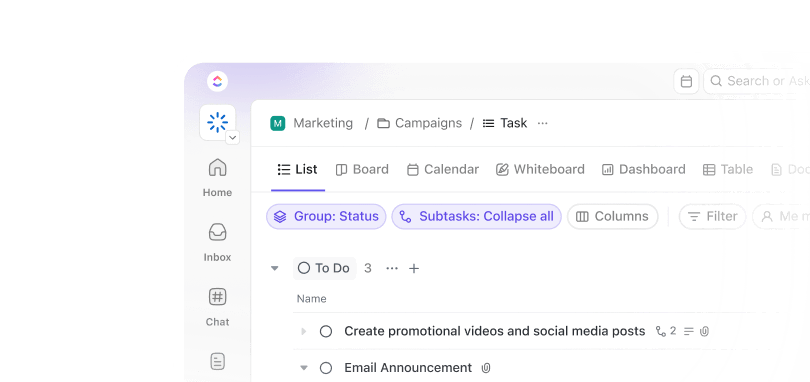We all know (and sometimes dread) that time of the year. 📆 Performance reviews!
You want to be honest, encouraging, and professional, while also providing constructive and intentional feedback.
Whether you’re giving feedback or receiving it, finding the right words is half the battle. Say too little, and it feels generic. Say too much, and you might be oversharing, or it might come off the wrong way.
But with the right phrases, performance reviews can turn into meaningful conversations that actually help people grow, not just tick a box once a year.
In this blog, we dive into performance review phrases that go beyond the usual “meets performance expectations” or “needs improvement.”
Keep reading if you’re a manager prepping for review season or an employee looking to self-reflect more effectively, we’ve got your back with phrases that are clear, constructive, and useful.
⚡️ Bonus: We’ll also show you how tools like can help you streamline the entire review process, from tracking goals to organizing feedback, all in one place.
Why Are Performance Review Phrases Important?
Think about the last time someone told you, “You’re doing a good job.” Nice to hear, right? But after the initial boost, you’re left wondering—what exactly did you do well? What should you continue doing? And what could you be doing better?
This is where constructive performance review phrases come into play. They’re not just formalities to pad out a document. They’re powerful communication tools that bring clarity, encourage growth, and keep everyone aligned. When used thoughtfully, they help managers deliver feedback that’s specific and constructive, and they give employees a clear sense of where they stand, what they’re excelling at, and where there’s room to grow.
They reduce miscommunication
Let’s say a manager tells an employee, “You need to be more proactive.” That could mean a dozen different things. Proactive in meetings? With deadlines? With clients? A well-crafted performance review phrase is far more specific and helpful.
They make feedback actionable
Vague feedback leads to confusion. Specific phrases turn observations into opportunities. For example, instead of saying, “You’re not a team player,” a better phrase might be, “During cross-functional projects, there were missed opportunities to collaborate more closely with other departments.” It’s a clear and constructive feedback, and points to something the person can work on.
They help set the tone and culture
The language used in reviews sets the tone for how feedback is received across the organization. Thoughtful phrasing fosters a culture of support and development rather than criticism or fear. It signals that feedback isn’t about judgment. It’s about helping each other get better.
They support fair, consistent evaluations
Using structured phrases helps reduce unconscious bias. When everyone’s performance is being assessed using consistent language and criteria, it becomes easier to ensure fairness, especially in larger teams or when multiple managers are involved in employee reviews.
How to Use Performance Review Phrases Effectively
Even the most well-written phrase can fall flat if it’s not used in the right context. To make sure your feedback truly lands, here are a few smart ways to use performance review phrases more effectively:
1. Anchor feedback in real situations
People respond better when feedback feels real and relatable. Don’t just say someone “shows strong leadership and interpersonal skills.” Highlight a moment where they led a project, resolved a conflict, or supported a teammate. It adds weight to your words and helps reinforce the behavior you want to encourage.
2. Keep it clear and constructive
Avoid vague language that leaves people guessing. Clear, actionable phrases make it easier for employees to know what’s expected and how they can grow. If something needs improvement, be honest but also offer direction.
3. Aim for balance
Performance reviews should reflect the whole picture. If you only focus on what’s working, employees might miss chances to improve. If you only highlight flaws, it can feel demotivating. A thoughtful mix of employee recognition and guidance leads to better engagement and trust.
4. Connect feedback to bigger goals
Effective feedback isn’t just about what someone did — it’s also about why it matters. Link your phrases to team objectives, company values, or personal development goals. This gives the feedback greater meaning and shows how individual contributions fit into the bigger picture.
5. Speak like a human
It’s tempting to rely on formal phrases or templates, especially during the review season, but the best feedback sounds authentic. Adapt phrases to your voice and make sure they reflect how you actually see the person’s performance. Sincerity beats polish, every time.
💡 Pro Tip: Use Brain with Docs to create your performance review phrases

Best Performance Review Phrases by Category
Category #1: Communication skills
Strong communication skills are the backbone of effective teams. Whether it is verbal, written, or active listening, how someone shares and receives information can deeply impact team productivity and collaboration. Here are performance review phrases you can use to reflect communication strengths or address areas for improvement:
Positive feedback phrases
- Communicates project updates clearly during stand-up meetings, ensuring everyone is aligned
- Listens attentively in one-on-one discussions and often asks clarifying questions to avoid misunderstandings
- Explains technical concepts in a simple, digestible way for non-technical team members
- Adjusts communication style when interacting with clients, peers, or senior leadership
- Responds to emails promptly and with all necessary context, reducing back-and-forth
- Provides clear, actionable, and constructive feedback during peer reviews without sounding critical
- Maintains transparency in team discussions, especially when project timelines shift
- Uses slides and visuals effectively during presentations to make complex data easier to follow
- Diffuses tension during difficult conversations by staying calm and focused on facts
- Clarifies expectations when assigning tasks, which minimizes confusion later
- Rephrases questions when teammates appear unsure, ensuring mutual understanding
- Shares key learnings after client calls so others can benefit from the insights
- Facilitates productive discussions by encouraging other team members to contribute
- Keeps cross-functional teams regularly informed by promoting open communication and updating shared channels.
- Uses meeting agendas to keep conversations focused and time-efficient
Constructive feedback phrases
- Often provides updates that lack necessary context, leading to confusion among other team members
- Needs to work on active listening skills instead of interrupting or multitasking during meetings
- Tends to use overly technical language in client calls, making it hard for them to follow
- Doesn’t always check for understanding when giving instructions, resulting in misalignment
- Can be slow to respond to messages, causing avoidable delays in time-sensitive projects
- Sometimes gives vague feedback that makes it unclear what action is expected
- Needs to be more mindful of tone when writing messages under pressure
- Overuses jargon in internal updates, which creates barriers for cross-functional teams
- Struggles to articulate ideas during team discussions, especially under stress clearly
- Could improve meeting communication by preparing more structured talking points
Category #2: Teamwork and collaboration
Being able to work well with others is essential in any role. Whether it’s building trust, supporting peers, or navigating conflict, strong collaboration leads to better results and a healthier work culture. Here are performance review phrases that highlight how an individual contributes to team dynamics:
Positive feedback phrases
- Proactively offers to assist teammates when workloads spike, without being asked
- Coordinates effectively with cross-functional teams during product launches to ensure timelines are met
- Shares resources and best practices with peers to improve overall team performance
- Works collaboratively during team brainstorming sessions, building on others’ innovative ideas
- Supports new team members by answering questions and helping them onboard smoothly
- Maintains a respectful tone and delivers constructive criticism during team disagreements
- Frequently volunteers for shared tasks like meeting notes or project documentation
- Communicates openly when facing blockers and asks for input from the team
- Encourages quieter team members to speak up during group meetings
- Helps the team stay focused during high-pressure projects without causing friction
- Steps up to coordinate assigned tasks when there’s a lack of direction, keeping momentum going
- Fosters trust within the group by following through on shared commitments
- Balances giving input with making space for others’ opinions
- Works seamlessly with remote team members, making them feel included in daily activities
- Contributes consistently to team goals while still respecting individual responsibilities
Constructive feedback phrases
- Tends to complete tasks in isolation without checking in with the rest of the team
- Has difficulty accepting valuable feedback from peers, which affects collaboration
- Needs to show more flexibility when teammates suggest alternative approaches
- Sometimes delays shared projects by not aligning with the team’s agreed-upon process
- Struggles to acknowledge teammates’ contributions in group projects
- Tends to take over discussions rather than encouraging group participation
- Could improve responsiveness when collaborating across departments
- Rarely offers support when others on the team are overwhelmed or under pressure
- Needs to participate more actively in shared team rituals, like retros or stand-ups
- Sometimes prioritizes individual goals over broader team objectives
Category #3: Problem-solving and critical thinking
Problem-solving and critical thinking are key to making sound decisions and driving progress. Employees who approach challenges with a structured mindset help avoid costly mistakes and find better, faster ways to reach goals.
The following performance review examples and phrases can help you communicate effectively how well someone navigates challenges or where they may need support.
Positive feedback phrases
- Quickly identifies the underlying issue when troubleshooting recurring client complaints
- Proactively suggests process improvements that reduce bottlenecks in team workflows
- Uses data from customer complaints and valuable feedback to propose product changes with measurable outcomes
- Anticipates potential roadblocks in projects and prepares backup plans
- Regularly asks thoughtful questions that challenge assumptions and spark new, innovative ideas
- Offers logical, step-by-step solutions when the team faces unexpected new challenges
- Handles ambiguous situations by breaking them down and identifying key priorities
- Demonstrates good judgment by balancing short-term needs with long-term goals
- Brings fresh perspectives to brainstorming sessions that lead to implementable ideas
- Collaborates across teams to find workable solutions rather than quick fixes
- Recognizes patterns in project delays and initiates system changes to prevent them
- Adapts previous learnings to solve new, unrelated challenges effectively
- Stays calm during crises and takes decisive action without rushing into decisions
- Encourages input from less vocal team members to uncover overlooked insights
- Follows up on implemented solutions to measure effectiveness and adjust when needed
Constructive feedback phrases
- Tends to rely on standard approaches even when they no longer produce results
- Needs to be more comfortable working through problems without always seeking guidance
- Often jumps to solutions before fully understanding the root of the issue
- Could improve the ability to prioritize when faced with multiple competing problems
- Misses opportunities to bring data or evidence into decision-making discussions
- Needs to take a more proactive role in solving issues instead of waiting for direction
- Sometimes overlooks the downstream impact of quick fixes
- Struggles with problem-solving when timelines are tight or priorities are unclear
- Could develop better follow-through after suggesting a solution
- Needs to focus on understanding context before offering feedback on complex challenges
Category #4: Leadership and initiative
Effective leadership and initiative are essential for driving team success and creating a culture of accountability. Great leaders take ownership, motivate others, and push teams to excel. The following phrases highlight strong leadership skills and the ability to take initiative, or point to areas where improvement may be needed.
Positive feedback phrases
- Takes initiative and ownership of team projects and ensures project deadlines are consistently met
- Identifies areas for team improvement and implements changes to boost team efficiency
- Leads by example, setting high standards for performance and work ethic
- Actively mentors junior team members, helping them grow in their roles
- Initiates new processes that improve team collaboration and reduce bottlenecks
- Proactively steps in during team challenges, providing guidance without micromanaging
- Inspires others to exceed their personal goals by setting ambitious but achievable targets
- Encourages a positive culture by regularly offering constructive feedback to peers
- Demonstrates strong decision-making abilities, even when faced with limited information
- Leads cross-functional meetings, ensuring all stakeholders are aligned and engaged
- Identifies and nurtures talent within the team, helping high performers advance in their careers
- Balances strategic vision with tactical execution, ensuring both short- and long-term goals are met
- Acts as a role model for professionalism and integrity, even during challenging times
- Takes initiatives that align with company values and drive team performance
- Builds a collaborative and positive work environment where everyone feels encouraged to contribute
Constructive feedback phrases
- Needs to delegate more effectively, as over-managing tasks limits team autonomy
- Has difficulty making quick team decisions when under pressure, leading to delays
- Could benefit from being more transparent with the team about decision-making processes
- Needs to involve team members more in strategic planning to foster greater ownership
- Should work on developing stronger conflict resolution and interpersonal skills to maintain team harmony
- Sometimes avoids difficult conversations with team members, letting issues persist
- Could improve in prioritizing team development alongside personal performance
- Struggles to keep up the team spirit and team morale during periods of low motivation or setbacks
- Needs to be more proactive in identifying potential problems before they escalate
- Could improve in recognizing and rewarding team efforts more consistently
Category #5: Productivity and time management
Strong time management ensures that tasks are completed efficiently and deadlines are met. It involves prioritizing effectively, staying focused, and using time wisely. Below are performance review examples that highlight an individual’s time management skills, productivity levels, and potential areas for growth:
Positive feedback phrases
- Consistently meets deadlines while maintaining a high quality of work
- Effectively prioritizes tasks based on urgency and impact, ensuring key projects are completed on time
- Organizes daily tasks using a clear, structured system that maximizes productivity
- Balances multiple competing priorities with ease and remains focused under pressure
- Demonstrates strong time management skills by consistently completing projects ahead of schedule
- Shows a proactive approach by breaking large tasks into smaller, manageable chunks
- Delegates non-critical tasks to others, freeing up time for high-priority work
- Uses productivity tools (e.g., task management apps, calendars) to stay organized and efficient
- Keeps team meetings focused and concise, ensuring that time is well spent
- Avoids distractions during working hours, maintaining a high level of focus throughout the day
- Keeps up with industry trends and adapts quickly when priorities shift to meet deadlines
- Consistently demonstrates the ability to handle a high volume of work without sacrificing quality
- Plans work in advance to ensure enough time for thoughtful execution
- Regularly tracks progress against deadlines to ensure project delivery on time
- Works efficiently even when managing a large workload, staying on task and focused
Constructive feedback phrases
- Needs to improve task prioritization to avoid last-minute rushes
- Occasionally misses deadlines due to poor time management and underestimating workload
- Struggles to maintain focus when juggling multiple tasks, which leads to unfinished work
- Tends to procrastinate on less engaging tasks, causing delays in project timelines
- Could benefit from creating more detailed plans to stay on top of ongoing responsibilities
- Needs to allocate more time for important tasks rather than getting caught up in smaller, less critical work
- Has difficulty adjusting priorities when new, urgent tasks emerge
- Could improve in time management for strategic thinking amidst day-to-day tasks
- Sometimes spends too much time on low-priority tasks at the expense of bigger projects
- Needs to refine time management strategies to prevent burnout during peak work periods
How to Write Your Own Performance Review Phrases
Sometimes, the most effective feedback is the kind you write yourself. Whether you’re a manager crafting personalized feedback or an employee writing a self-evaluation, knowing how to write performance review phrases that are clear, constructive, and specific makes all the difference.
Here’s a simple framework to guide you:
1. Start with the behavior
Begin by stating the specific action or behavior. Avoid generalities like “positive attitude”, “negative attitude”, or “strong performer.” Instead, pinpoint what was done using observable details.
Example: “Consistently met weekly deadlines for client reports without compromising on accuracy.”
2. Tie actions to results using the STAR method
Go beyond what was done and explain why it mattered. The STAR method (Situation, Task, Action, Result) is a helpful way to structure feedback. Highlight the impact of the action on team or company outcomes.
Example: “In Q1, took ownership of client onboarding (Situation/Task), introduced a checklist system (Action), which led to a 30% faster onboarding process (Result).”
3. Use data and specific examples
Whenever possible, support your phrases with quantifiable data or examples. This adds credibility and removes ambiguity.
Example: “Resolved 95% of customer complaints within 24 hours over the past quarter.”
4. Maintain a professional growth mindset
Whether you are highlighting wins or areas to improve, use language that encourages development. This helps reinforce the idea that performance can evolve with effort and support.
Example: “I’m continuing to build confidence in public speaking and plan to lead more team presentations next quarter.”
5. Use objective, professional language
Stick to facts and behaviors. Avoid emotional or vague statements and focus on what was seen, done, or delivered.
❌ Instead of: “You were kind of disorganized.”
✅ Try: “Occasionally missed deadlines, which delayed cross-functional deliverables.”
6. Customize to the role
Tailor your language to reflect the responsibilities and performance expectations of the specific role. Each function has different success criteria, and your review phrases should reflect that.
7. Leverage performance tracking tools
Use tools like to track progress toward goals, capture feedback throughout the review cycle, and reference past performance data. Having this documentation on hand makes writing review phrases easier, more accurate, and unbiased.
Streamline Employee Performance Reviews with
Managing performance reviews efficiently can be a daunting task, but with , the process becomes streamlined and more effective. By integrating robust project management features with performance tracking tools, helps HR teams, managers, and employees maintain transparency, align on goals, and make the feedback process more actionable. Here is how can transform your employee performance reviews:
Centralized performance data and documentation
One of the most common challenges with employee performance reviews is gathering, organizing, and referencing feedback from various sources. With ’s centralized task management, all feedback, project updates, and employee performance records are stored in one place.
This eliminates the need to search through scattered emails or documents to compile data for reviews. Managers can easily reference completed tasks, ongoing projects, and employee self-assessments without losing track of any key information.


AI-powered performance insights
offers AI-powered features that automatically analyze data from tasks, projects, and even comments to provide unbiased performance management insights. By evaluating task completion rates, deadlines met, and collaboration across teams, helps managers pinpoint an employee’s strengths and areas for improvement.
This minimizes subjective feedback and ensures that evaluation phrases are based on real, measurable outcomes. Using this AI-driven approach, feedback becomes both data-rich and actionable, supporting employees’ professional growth.
Visual performance management dashboards
’s Dashboards are powerful tools for visualizing employee performance at a glance. With the ability to track project progress, missed deadlines, and individual KPIs, dashboards offer managers a quick, clear overview of performance management metrics.
These visual insights make it easy to spot trends, recognize achievements, and identify new challenges without going through lengthy reports. Whether tracking individual or team goals, dashboards bring clarity to performance reviews, helping managers make informed team decisions.
Clear goal setting with Goals and OKRs


Setting clear, measurable goals is the foundation of any effective performance review. ’s Goals feature allows teams to align individual goals with broader company objectives. By tracking both qualitative and quantitative results, ensures that performance reviews are tied to clear, actionable goals.
Ready-made performance review templates
simplifies the entire review process with pre-built performance review templates. These templates are customizable, allowing managers to quickly set up employee evaluation process that include everything from self-assessments to manager feedback. This reduces administrative work and ensures that all essential criteria are covered in every review. With templates for different roles and levels, ensures a consistent, thorough process for performance evaluations across the organization.
Tips for Conducting Effective Performance Reviews
A well-executed performance review can drive meaningful growth, alignment, and motivation. Here’s how to keep the process impactful and efficient:
- Come prepared with data: Review the employee’s performance history, peer feedback, and progress on goals. Preparation ensures the conversation stays objective and focused.
- Set a comfortable environment: Choose a private, quiet setting that encourages open, distraction-free dialogue. A supportive atmosphere builds trust.
- Give clear, balanced feedback: Recognize strengths and address areas for improvement using specific examples. Avoid vague comments and tie feedback to measurable results.
- Maintain a collaborative work environment: Encourage employees to share their thoughts, challenges, and aspirations. Two-way conversations build ownership and engagement.
- Define SMART goals together: Work with the employee to set specific, measurable, achievable, relevant, and time-bound goals that support both individual growth and team objectives.
Use SMART Goals template to to set clear, actionable objectives, track progress efficiently, and stay aligned with your team’s priorities.
- Follow Up and Document Everything: Summarize key takeaways and next steps after the review. Regular check-ins ensure accountability and continued progress.
Turn Feedback Into Forward Momentum
Effective performance reviews are essential for professional growth and alignment within teams. By using clear, actionable feedback and leveraging tools like , you can ensure reviews are more efficient, data-driven, and focused on measurable outcomes. With the right preparation, open communication, and follow-up, employee performance reviews can become a key part of ongoing development, helping both individuals and teams reach their full potential.
Ready to simplify performance management? Start using to effortlessly track feedback, foster growth, and empower your team to thrive.


Everything you need to stay organized and get work done.














